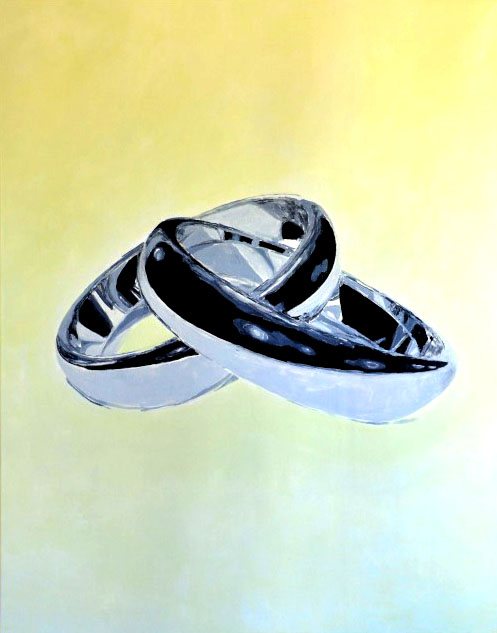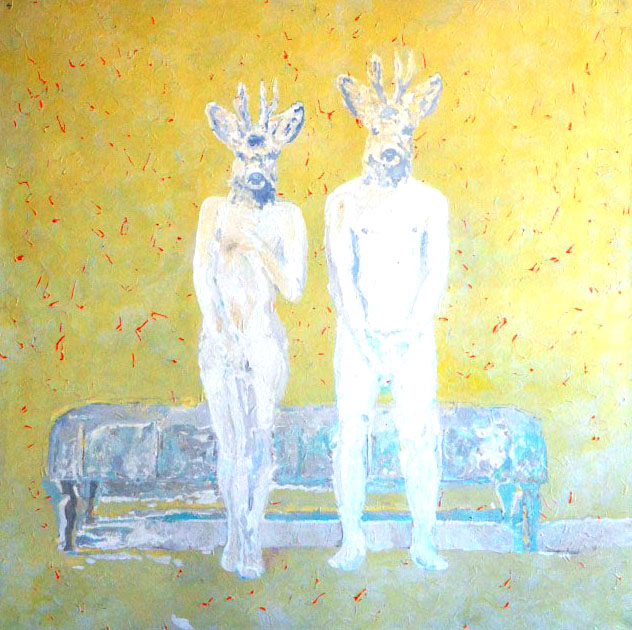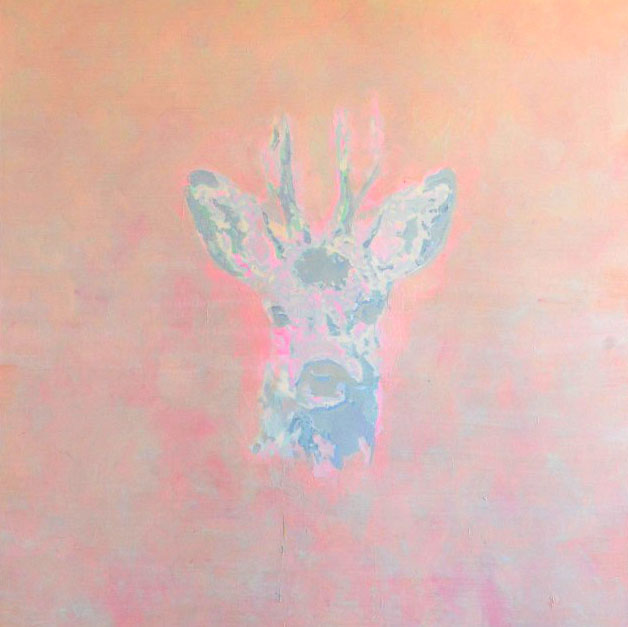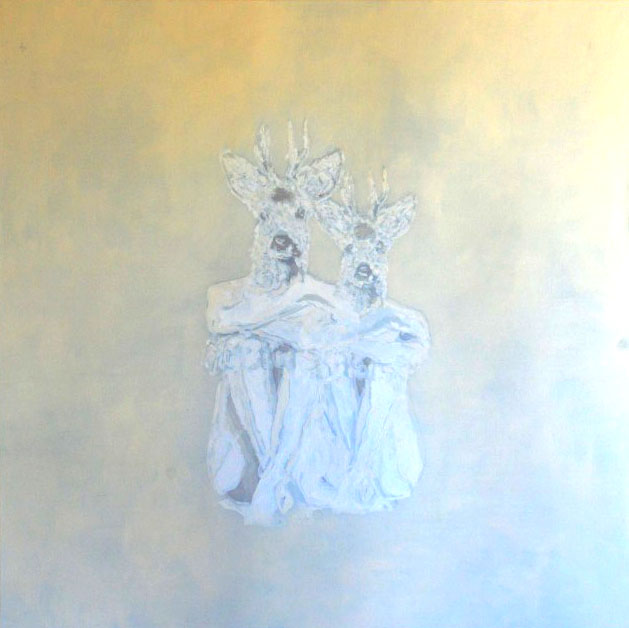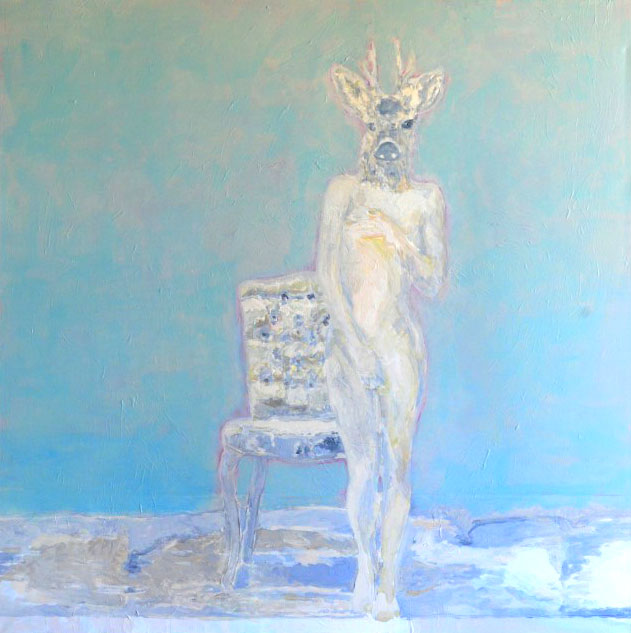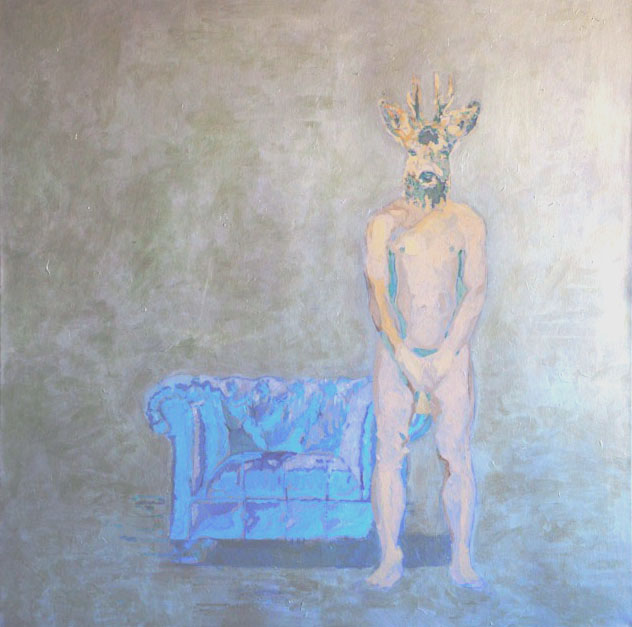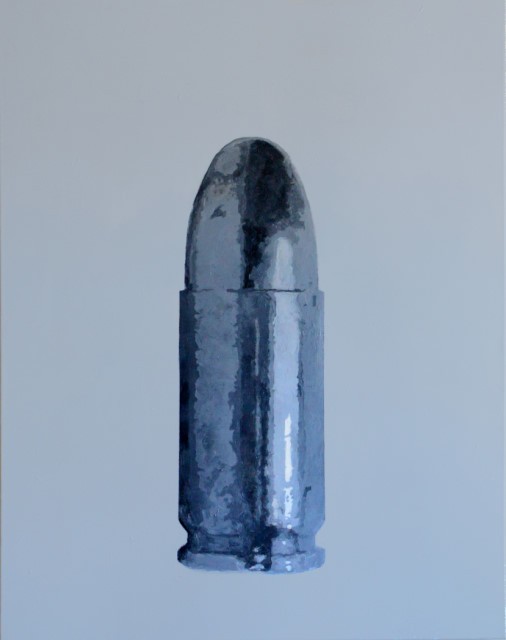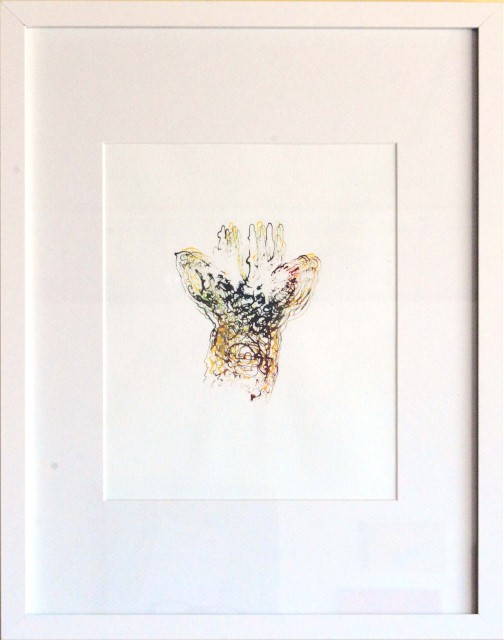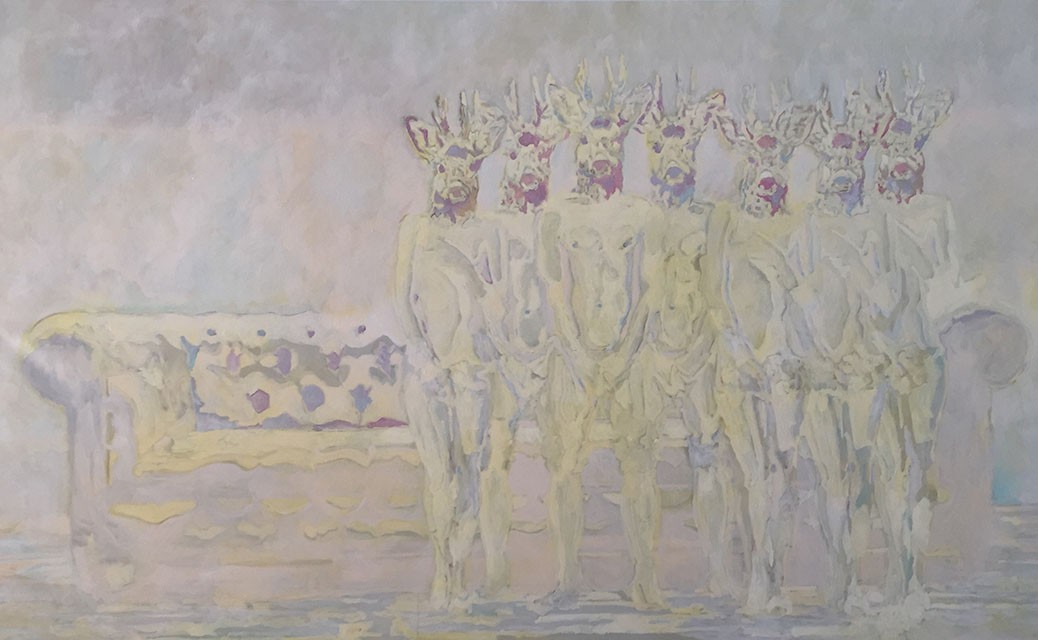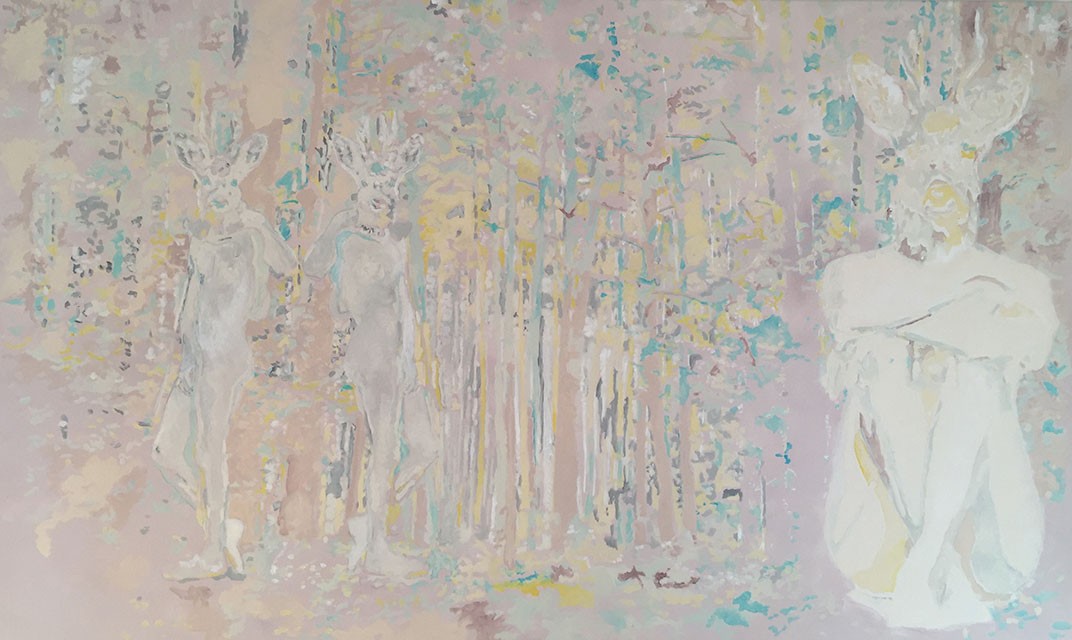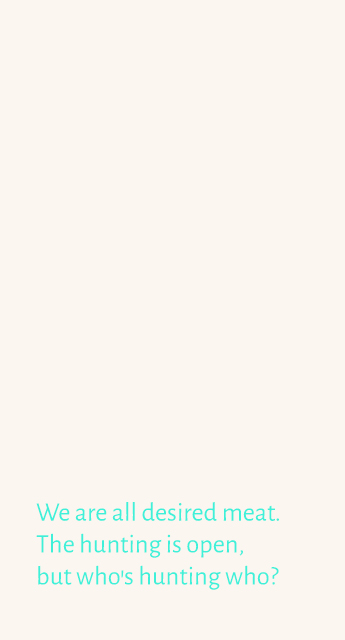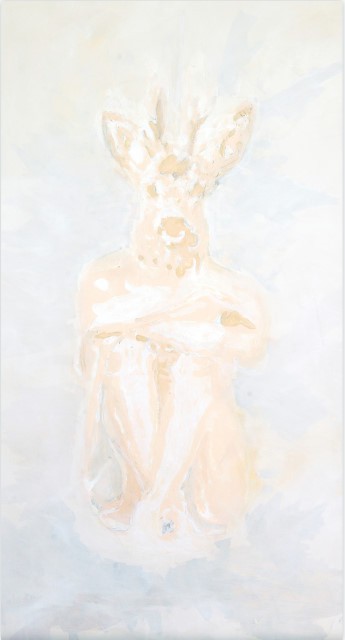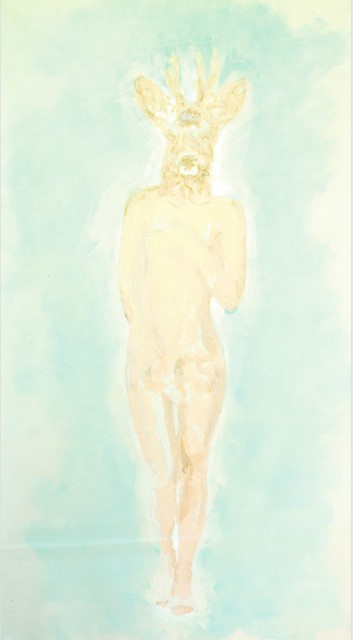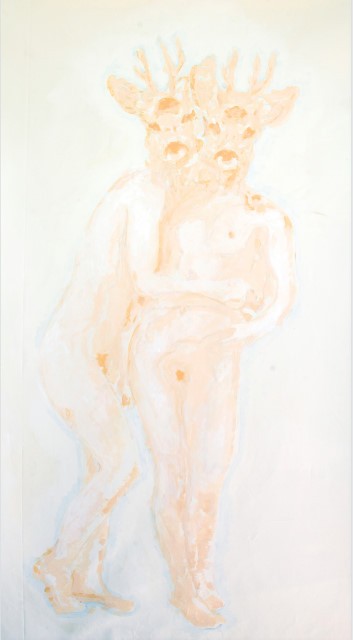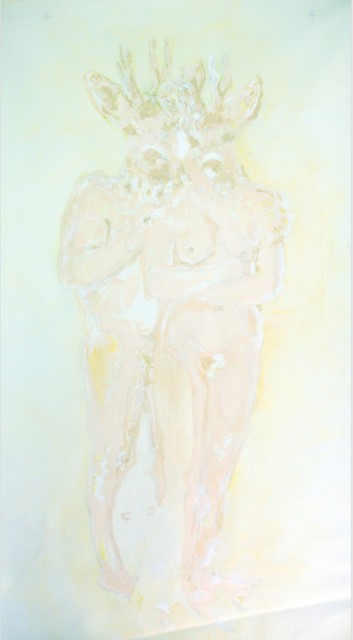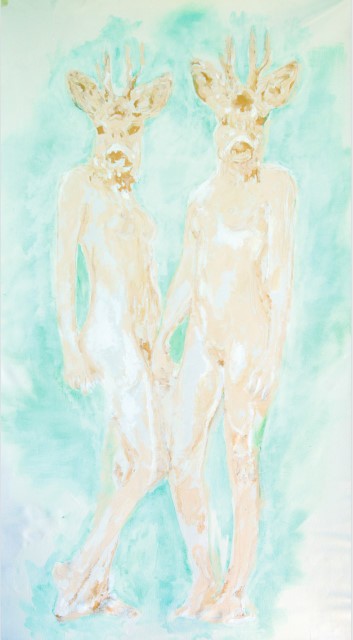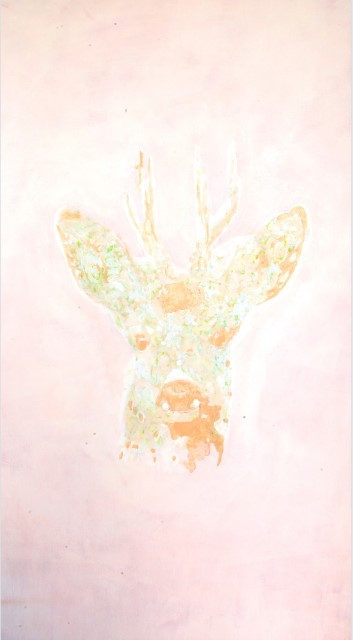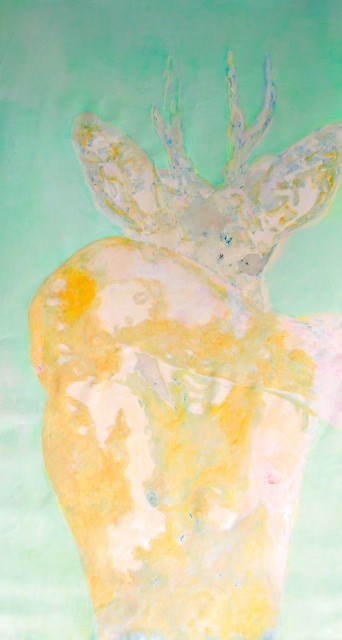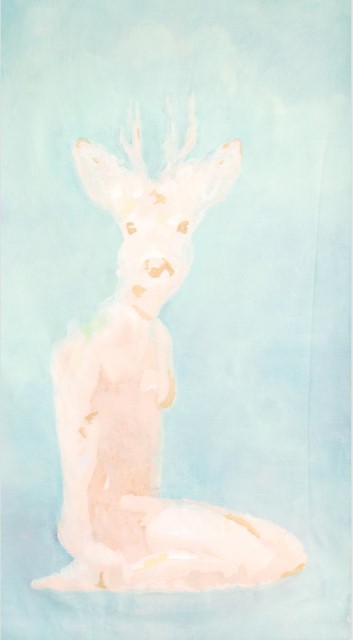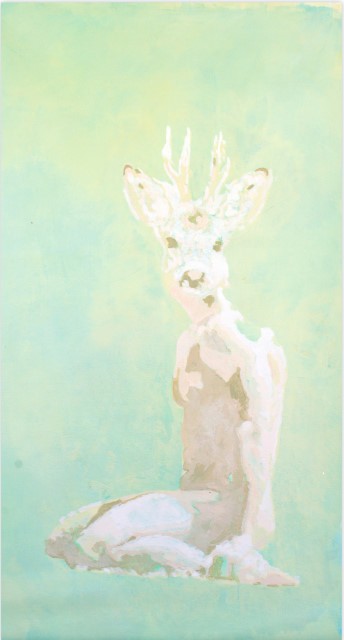For HUNT project.
Surfaces games
Federico Baeza, Art curator.
Masks are arrested expressions and admirable echoes of feeling, at once faithful, discreet, and superlative. Living things in contact with the air must acquire a cuticle, and it is not urged against cuticles that they are not hearts; yet some philosophers seem to be angry with images for not being things, and with words for not being feelings. Words and images are like shells, no less integral parts of nature than are the substances they cover, but better addressed to the eye and more open to observation.
George Santayana, Soliloquies in England and Later Soliloquies, 1922.
Figures dimly emerge from mist, a barely colored whiteness, so thick that it only allows us to recognize the presence of subtly outlined bodies on a background without horizons or apparent landforms. Insinuated silhouettes, elusive lines and tones. Surrounded by this dense atmosphere, we are examined by the frontal and symmetric presence of deer heads that overlap with these vaguely outlined human anatomies.
The grimace on these heads shows an impending threat; something is stalking them. As in TV documentaries about wild life in dense woods, arid steppes or green plains, the face of the deer seems to be frozen in the exact moment it detects the hunter. Its head turns violently, upright ears point at danger, its minute, dark and blank eyes sense us. On the surface of the painting, in this evening clarity suspended in time, the eyes of the deer are cracks, notches of unsaturated colors.
In the room you are going through, figures appear to be looking for each other; they observe and suspect each other; they are on guard. Alone, or in pairs, they look at each other. You may think that the face of the deer is a mask, and that the hunter´s imagination has imprinted that deer's mask as a code for what he considers his prey.
At the end of the 1950s, Erving Goffman recalls that the original meaning of the word person is mask. The father of microsociology found this etymological origin very useful: in the little scenes of our relationships, in our wishes, in our hunting targets, we create roles, masquerades, surfaces games that we use to decode the enigma that the other represents and, at the same time, to create an image of ourselves.
In the clarity of the pictorial surface you are observing, the outline of the hunter does not appear. Maybe his territory is not permanent; this predator can be a floating place, some sort of mist that impregnates all the space in the room. A blurred hunter within the environment. These bodies can be predators and prey at the same time when they look at each other alternately. This is a game of reflections and transparencies, a land of attempts, between actions and predictions, steps forward and setbacks.
In the series Hunt, Daniel Romano wonders once again about a situation that has been keeping him awake for some time: the perimeter of our interpersonal relationships, the invisible threads that coordinate calculations and tactics within the winding limit of our closest bonds. Within these personal politics, there are surfaces games, mirrors where we, and the others, create a profile. Masks, skins, cuticles, arrested expressions and admirable echoes of feeling. In the image, in the painting, wishing appears. It is not urged against cuticles that they are not hearts.
Federico Baeza
(Buenos Aires, Argentina, 1978) He is researcher, critic and teacher specializing in contemporary art. He graduated in arts and history and art theory at the Faculty of philosophy and letters by the University of Buenos Aires. He received doctoral scholarships awarded by the University of Buenos Aires and CONICET. It has developed research in the Centre for studies and documentation of the MACBA (Barcelona) around the heritage of the institution on Argentinian conceptual artists. More recently, he works in the field of arts management developing curatorships as the project of a retrospective of Argentine artists of the last ten years to cycles of talks scheduled from the area of University extension of IUNA and OSDE Foundation. It is currently director of extension and institutional linkage, Adjunct Professor of undergraduate and graduate in the area of criticism of Arts IUNA. He is co-author of three books on Visual and performing arts, publishes articles on contemporary art in journals, write catalogues of artists and regularly participates in conferences and other national and international meetings for a decade. It develops research and scripts for Encuentro channel about contemporary art.
...............................................................................................................................................................
Para el Proyecto HUNT.
Juego de superficies
Federico Baeza, Curador.
Las máscaras son expresiones fijas y ecos admirables de sentimientos, a un tiempo fieles, discretas y superlativas. Los seres vivientes, en contacto con el aire, deben cubrirse de una cutícula, y no se puede reprochar a las cutículas que no sean corazones. No obstante, hay ciertos filósofos que parecen guardar rencor a las imágenes por no ser cosas, y a las palabras por no ser sentimientos. Las palabras y las imágenes son como caparazones: partes integrantes de la naturaleza en igual medida que las sustancias que recubren, se dirigen más directamente a los ojos y están más abiertas a la observación.
George Santaya,
Soliloquies in England and Later Soliloquies, 1922.
Las figuras emergen débilmente de la bruma, una blancura apenas coloreada pero tan espesa que sólo permite reconocer la presencia de cuerpos sutilmente recortados sobre un fondo sin horizontes ni accidentes aparentes. Contornos sugeridos, líneas y tonos elusivos. En la densa atmosfera nos interpela la presencia frontal y simétrica de unas cabezas de ciervo que se yuxtaponen a estas anatomías humanas vagamente esbozadas.
El rictus de estas cabezas señala una amenaza inminente, algo las acecha. Como en los documentales de la televisión sobre la vida natural en densos bosques, áridas estepas o verdes llanuras, el rostro del ciervo parece detenido en ese momento en el que ha detectado a su cazador. Su cabeza gira violentamente, las orejas alzadas apuntan en dirección al peligro, sus ojos diminutos, oscuros, inexpresivos, nos intuyen. En la superficie de la pintura, en esta claridad vespertina suspendida en el tiempo, los ojos de los ciervos son hendiduras, muescas de colores con poca saturación.
En la sala que ahora usted está recorriendo las figuras parecen buscarse entre ellas, observarse, recelarse, ponerse en guardia. Solitarias, o en pareja, se devuelven la mirada recíprocamente. Podría pensarse que el rostro del ciervo es una máscara, también que la imaginación de un cazador ha impreso esa máscara de ciervo como un código sobre aquello que considera su presa.
A finales de la década del 50 Erving Goffman recuerda que el significado original de la palabra persona es máscara. El padre de la microsociología sacó mucha utilidad de este origen etimológico: en las pequeñas escenas de nuestras relaciones, en nuestros deseos, en nuestros objetivos de caza, construimos roles, mascaradas, juegos de superficies en los que intentamos descifrar el enigma que el otro representa y, simultáneamente, nos damos una imagen de nosotros mismos.
En la claridad de la superficie pictórica que usted ahora observa, los contornos del cazador no se hacen presentes. Tal vez su territorio no se encuentre fijo, este depredador puede ser un lugar flotante, una suerte de niebla que impregna todo el espacio de la sala. Un cazador difuminado en el ambiente. Estos mismos cuerpos pueden ser al mismo tiempo depredadores y presas al mirarse alternativamente, se trata de un juego de reflejos y transparencias, un terreno de escarceos, entre acciones y previsiones, adelantos y retrocesos.
En la serie Caza Daniel Romano vuelve a preguntarse por un escenario que hace tiempo lo desvela: el perímetro de nuestras relaciones interpersonales, los hilos invisibles que coordinan cálculos y tácticas en el sinuoso perímetro de nuestros vínculos más próximos. En estas políticas de lo personal existen juegos de superficies, espejos en los que propios y ajenos conjuran un perfil de sí mismos. Máscaras, pieles, cutículas, expresiones fijas y ecos admirables de sentimientos. En la imagen, en la pintura, se conjuga el deseo. No se puede reprochar a las cutículas que no sean corazones.
Federico Baeza
(1978) es investigador, docente y curador especializado en arte contemporáneo. Es licenciado en Artes y doctor en Historia y Teoría de las Artes en la Facultad de Filosofía y Letras por la Universidad de Buenos Aires (UBA). Es becario postdoctoral del Consejo Nacional de Investigaciones (CONICET), ha obtenido anteriormente becas doctorales otorgadas por la UBA y el CONICET desde 2010. Más recientemente, se desempeña en el campo de la curaduría desarrollando exhibiciones y actividades en el país. Obtuvo el Primer Premio en el Programa Jóvenes Curadores en la edición de arteBA 2014 y el Primer Premio del Concurso Curadores 10° Aniversario Macro 2014. Actualmente es director de Extensión Universitaria, profesor adjunto de grado y posgrado en el Área de Crítica de las Artes de la Universidad Naciona de las Artes (UNA). Es coautor de libros sobre artes escénicas y visuales, publica artículos sobre arte contemporáneo en revistas especializadas, escribe en catálogos de artistas y participa en congresos y otros encuentros nacionales e internacionales regularmente desde hace más de una década.
